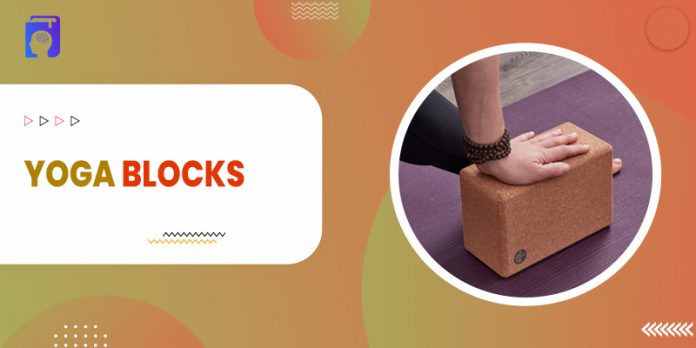Assumingly, yoga is the elixir of your life. Each day, you take time from your hectic schedule to indulge in breathing techniques and restorative poses for some tangible health benefits. Now it’s time to take your practice to yet another level where yoga is central to the way you walk, eat, sleep, work and play. Simply put, it’s time to add yoga blocks to your practice.
Yoga blocks are a success enabler for newbies and seasoned practitioners alike. As the name says it all, these blocks are used as a prop by yoga practitioners. The material could be wood, rubber or plastic. They come in all shapes and sizes to suit all needs.
What are Yoga Blocks?
BKS Iyengar is credited with introducing these blocks in the 1970s. Since then, they have steadily emerged as a staple for support, alignment, and stability during yoga practice. As a side note, the yoga market has hit the USD 130 billion mark. And, accessories have a growing share of it with yoga blocks being one of the most sought-after buys.
Types of Yoga Blocks
When you are in the market for yoga mats, be prepared to be spoilt for choices. Speaking of size, it ranges from 2 to 4 inches with the most common dimension being 4″ x 6″ x 9″. Some manufacturers, interestingly, label the slimmer ones as “bricks”. So, for all intents and purposes, bricks and blocks mean the same, save for the thickness.
The most ubiquitous shape is the cube with perfectly cut edges. Typically, the height, breadth and thickness remain uniform in these blocks for better support and safety. However, you might come across oval-shaped blocks that ensure more comfort but lesser support.
1. Wooden Blocks
Manufacturers often experiment with the materials. However, wood is the material of choice for most. You can rely on the wooden blocks for superb support and long life. But they lack comfort and are bulky, costly, and unsafe to use when wet. As a more viable option, you have hollowed wood blocks that are portable but brittle and costly.
Typically, manufacturers count on hardwoods, such as maple and birch for production. Weighing over a kilo, these blocks are on the heavier side and practically last forever. On the other hand, the hollowed blocks are bamboo-based. You might come across pine and other softwood blocks that are lighter, easier to store and carry than the hardwood ones.
2. Cork Yoga Blocks
Looking for a sustainable option? Well, in that case, cork blocks make sense. However, it’s worth noting that the sustainability factor is subject to cork harvesting techniques involved. Ranging from 450 grams to 900 grams, they are lighter than their wooden counterparts and smoother, softer, and easier to grip, store and stack as well.
On the downside, cork yoga blocks fare badly when it comes to absorbing sweat. That makes them hazardous to handle, especially when they are worn out. And, they are prone to wear and tear and require constant upkeep. Plus, their odor might turn you off.
3. Rubber Yoga Blocks
Make way for the lightest blocks out there, weighing anywhere between 150 to 350 grams. Being easy to stack and carry, you are free to carry them around wherever life takes you. However, light-weightiness isn’t their only USP, as they are also economical, durable, and convenient to upkeep. Unsurprisingly, a majority of yoga studios rely on these blocks.
Eager to buy them? Not so fast! Mind you, they also involve trade-offs. Some practitioners find them to be too soft and low on support, particularly when performing intricate poses. Also, they are susceptible to wear and tear and have a higher ecological impact. That said, they are ideal for restorative poses where you require comfort more than support.
Do We Really Need Yoga Blocks?
It’s a million-dollar question that every buyer has to find an answer to. You have multiple alternatives to blocks, think books, cushions, blankets, and more. While the stack of books is unstable and inconvenient to deal with, cushions and blankets lack the desired support.
On the other hand, yoga blocks are designed for support, convenience, and more. Plus, these blocks are easy on the pocket, costing a few hundred bucks. So, we advise you to give them a try. Need more convincing arguments? Well, here they come.
1. Reach Out:
It’s but obvious!
Depending on the size, these blocks bring down the distance between you and the yoga mat. Imagine doing a bending pose. Having a block or a couple of blocks under your hands would help you make it to the ground minus the effort and strain. Also, feel free to alter advanced asanas according to your flexibility while warding off any discomfort.
2. Safer Practice:
This is perhaps the biggest reason to incorporate the best yoga blocks into your practice. With blocks cushioning your knees and posteriors, you achieve the desired support and safety, which is otherwise missing. For those with sleepy legs and joint pains, these blocks become indispensable for safely practicing Vajrasana, Kurmasana, and other sitting poses. Provided you use height-adjustable blocks, switching between the asanas is stress-free.
3. Align It Right:
Asanas require the right alignment. Or else, you run the risk of hurting yourself. When the wrongly-aligned asanas aren’t an option, you need yoga blocks. Most practitioners lack the ability to perform a full side angle pose like Utthita Parsvakonasana, which requires proper alignment. If you are one among them, the right yoga block can come to your rescue.
4. Just for Support:
These props have another key benefit, providing support that is. Complex asanas require some support, especially if you are new to yoga or even an intermediate-level practitioner. Take, for instance, Bakasana, which asks you to elevate your foot. In lack of support, it’s impossible for many and painful for some. So, just have a block under your arm and you are sorted. Simply put, blocks facilitate your advancement to complex poses.
The Best Yoga Blocks
By now, you must be hard-pressed to buy yoga blocks. The caveat is, you don’t know where to start from. Well, Duniakagyan has you covered. For over a month, we tested hundreds of yoga blocks for their performance, sustainability, comfort, stability, price and more.
So, we are in a position to guide you on your best options out there.
Without any further ado, let’s get started!
1. The Best Overall – Gaiam Yoga Block
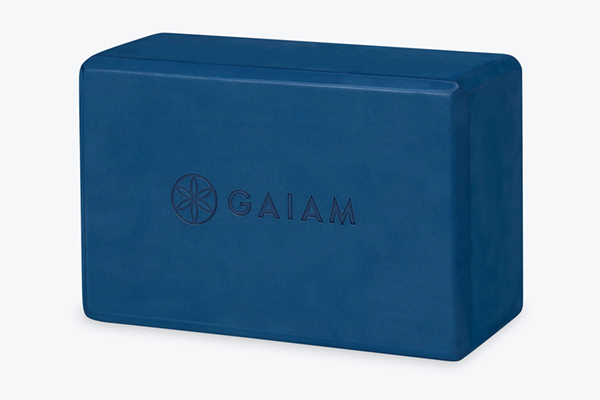
- Brand: Gaiam
- Material: Foam
- Shape: rectangular
- Thickness: 4 inches
- Ideal for: Stretches
It makes sense for anyone seeking something traditional and easy to use. During testing, we found the block to be high on support, eye appeal, and compactness.
What do we like about it?
- Featuring EVA foam, the block offers the right support for advanced poses
- Thanks to the beveled edges and slip-resistant surface, it offers a great grip.
- It’s lightweight enough to go with you to yoga studios and trips.
- The variety is astounding with multiple hues and prints available
- Feel free to customize its look and feel. It’s highly customizable.
- We found it an ideal fit for newbies and veterans alike
- The best part: it is easy on the pocket
What we didn’t like?
- Cannot match the wooden blocks in terms of sturdiness and durability
2. The Best for Beginners – Manduka Yoga Block
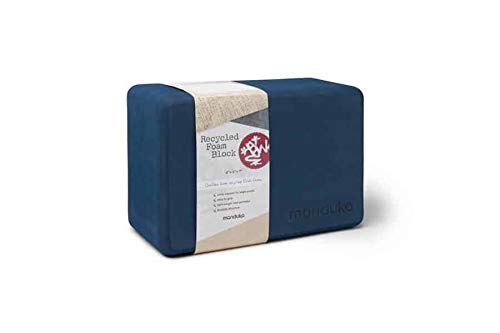
- Brand: Manduka
- Material: Foam
- Shape: Rectangular
- Thickness: 4 inches
- Ideal for: Beginners
If you are about to embark on your yoga journey, this could be your best bet. It lacks the frills and eye appeal but has what it takes to be a beginner-friendly block. Think exceptional sturdiness, great support, portability, longevity, and more. Made of recycled materials, the block is easy on the ecology. To top it all, it’s budget-friendly as well.
What do we like about it?
- Our testing revealed that it’s highly sturdy, capable of withstanding your weight even during standing asanas. Also, it can last a lifetime of use and abuse.
- Made of recycled materials, and hence, it is a sustainable option for environmentally friendly practitioners.
- Weighing 270 grams, the block is easy to carry along.
- We found the block to be comfortable on the knees, neck and wrists.
What we didn’t like?
- It is firmer than most yoga blocks on the list. That can hamper your experience.
- The “Practice On” engraving steals the smoothness of the surface.
- Cleaning and upkeep can be an issue, as our testing confirms.
3. The Best Combo – Reehut 2-Pack Yoga Blocks
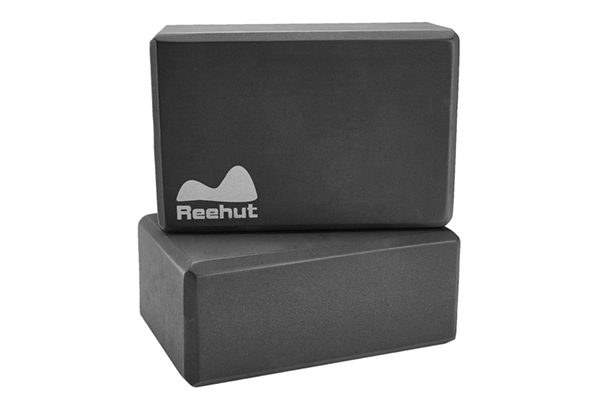
- Brand: Reehut
- Dimensions: 9 x 6 x 4 inches
- Material: Foam
- Weight: 160 grams
- Ideal for: Newbies and Veterans
Looking for a couple of yoga blocks to bolster your practice? In that case, don’t go any further than Reehut’s twin pack yoga block. You get two blocks that fare decently on our testing criteria, thanks to an impeccable construction featuring EVA foam.
What did we like about it?
- The EVA foam makes it long-lasting, semi-pliable and highly comfortable
- Like any combo pack, it offers value for money.
- Lightweight and compact, the blocks can be your perfect travel companion.
- Stability and support come by default, thanks to the ergonomic design.
- The company claims them to be moisture resistant. And, our testing confirms that.
- We found these blocks ideal for placement beneath arms and legs during stretching and kneeling down.
What we didn’t like?
Some of our users found them to be too small and light for their liking.
4. The Best Egg-Shaped Yoga Block – Three Minute Egg
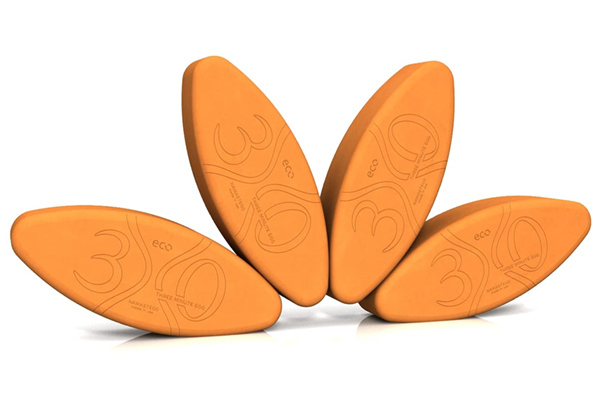
- Brand: Three Minute Egg
- Length: 12 inches
- Material: ECO Foam
- Weight: 200 grams
- Ideal for: Newbies and Veterans
The human body isn’t square. So, why should your yoga block be square? Well, that is the inspiration behind Three Minute Egg’s egg-shaped yoga blocks. The unique shape makes the block stand out and so does its blend of sustainability, support and strain-relief.
What do we like about it?
- The block is designed to contour the spine, making it ideal for those with spinal issues. Plus, it provides strain relief to the neck and back during restorative asanas.
- It comes with ECO Centric foam, which is fully biodegradable and recyclable. That’s a big plus if environmental degradation is a concern for you.
- The shape and surface make it easy to grip, which translates to an incidence-free yoga or pilate session.
- Like all foam yoga blocks, it is lightweight and compact, and hence, readily portable.
- We didn’t notice any pungent odour during testing, which can otherwise put you off.
What we didn’t like?
- As our testing reveals, sturdiness is an issue. It can come apart when subjected to the total body weight, particularly during standing asanas.
- The shape is unique but limiting as well. We found it less effective than the square and rectangular blocks for certain asanas.
5. The Best Hollow Yoga Blocks – Wooden-Life Bamboo Yoga Block
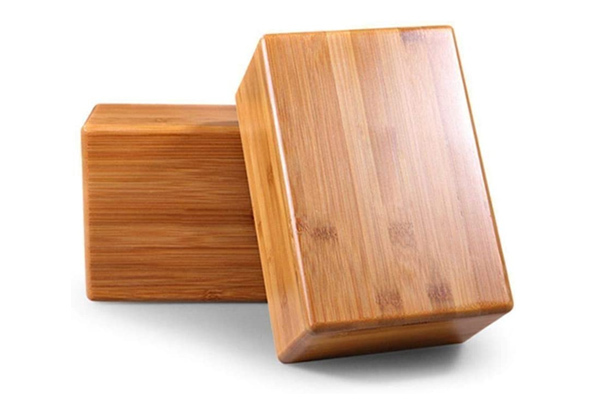
- Brand: Wooden Life
- Thickness: 3 inches
- Material: Bamboo
- Ideal for: All
So, a hollow wood yoga block is what you seek. Well, in that case, we recommend Wooden Life Bamboo Yoga Blocks. These high-density blocks are tailormade for comfort, support and grip.
What Did We Like About It?
- The lacquer coating ensures a better grip for safe yoga sessions.
- Built to last, these blocks can endure heavy weights without getting disfigured.
- You can rely on them for moisture resistance, and easy stacking and storage.
- Made of bamboo, they are an environmentally-friendly product.
- They are competitively priced to suit all pockets.
What we didn’t like?
- Require regular cleaning and upkeep. Even air-drying might be required.
Conclusion
So, that was all you needed to know about yoga blocks, from types, materials, applications to the best options out there. Key to taking your yoga practice to the next level, the blocks are more than an accessory. However, the benefits can be derived only if you choose well. By now, you have an idea of what to pick when you are in the market for yoga blocks.
People are also reading:



